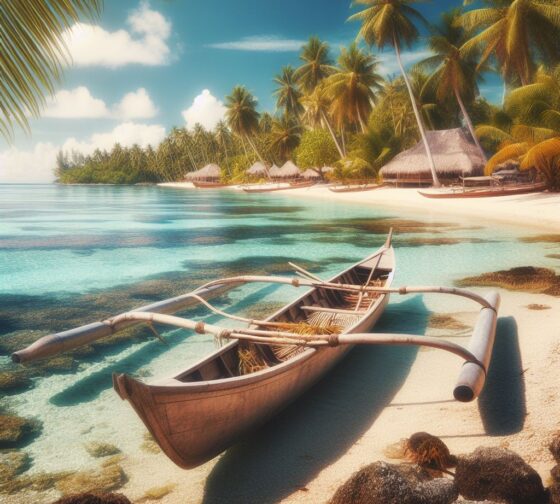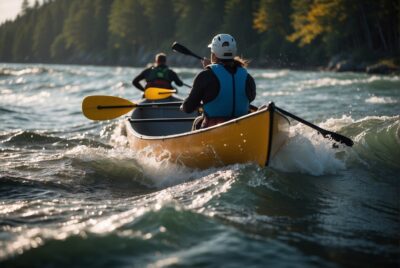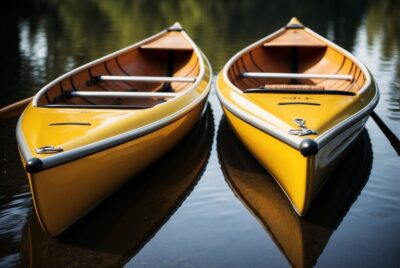Hawaiian Canoe: Exploring the Rich History
*We may earn a commission for purchases made using our links. Please see our disclosure to learn more.
Hawaiian Canoe: Exploring the Rich History
Ever wondered how ancient Hawaiians traveled vast ocean distances? The Hawaiian Canoe or more modernly know as outrigger canoes, were their secret arriving in Hawaii around 200 AD. This blog post will take you on a journey through the history and evolution of these remarkable vessels.
Dive into the story with us!
History of a Hawaiian Canoe
The history of Hawaiian canoes dates back to 200 AD when outrigger canoes first arrived in Hawaii, influenced by traditional configurations from Polynesia, Micronesia, and Madagascar.
These canoes hold great significance in Hawaiian culture and have a rich history of exploration and maritime traditions.
Arrival of outrigger canoes in Hawaii (200 AD)
Long ago, brave Polynesian explorers journeyed across the vast Pacific Ocean. They reached Hawaii, bringing with them their outrigger canoes. These special boats had floats attached to one side, helping them stay balanced on waves.
Voyagers from islands east of New Guinea started coming to Hawaii even before 200 AD.
Outrigger canoes became very important in Hawaiian life. Fishermen used them to catch food from the sea. People traveled between islands and explored new places with these sturdy vessels.
The arrival of these canoes started a big part of Hawaiian history and culture that is still alive today.
Traditional Configurations in Polynesia, Micronesia, and Madagascar
Polynesian canoes, including those in Hawaii, typically feature a single outrigger on one side for stability. The hulls are often carved from large trees, and the sails were traditionally made from woven pandanus leaves or plant fibers.
Micronesian canoes are also known for their outriggers and generally have a similar design to the Polynesian ones. In Madagascar, traditional pirogues often have dugout hulls and are propelled by paddles or occasionally sails made of mats or cloth.
These configurations showcase the ingenious designs that allowed ancient seafaring peoples to navigate vast ocean expanses.
Significance of Outrigger Canoes in Hawaiian Culture
The outrigger canoes hold immense significance in Hawaiian culture, reflecting the island civilization’s deep connection with the ocean. These traditional watercraft not only served as vital transportation for fishing and travel but also symbolized the Polynesian exploration traditions that led to the discovery of Hawaii.
The practice of outrigger canoeing was crucial to Hawaiian culture for centuries and played a pivotal role in shaping their maritime history, contributing to their nautical heritage and navigation techniques.
The revival of this ancient tradition through modern voyaging canoe clubs and competitions underscores its cultural importance. With the Hōkūleʻa circumnavigating the globe to revive Hawaiian exploration, enthusiasts celebrate the indigenous roots of outrigger canoes and honor their enduring legacy in Pacific Islander history.
Evolution of a Hawaiian Canoe

Hawaiian canoes have undergone significant evolution, from the modification of sails and booms to their use for fishing, travel, and exploration. Today, modern outrigger canoe clubs and competitions continue to showcase the enduring legacy of these iconic watercraft.
Modification of Sails and Booms on a Hawaiian Canoe
Hawaiian canoes have evolved over time, including modifications to their sails and booms. The design changes allowed for better maneuverability and speed, enhancing the overall performance of the canoes.
These modifications have contributed to the versatility of traditional Hawaiian canoes, enabling them to be used not only for transportation but also for fishing and exploration. The evolution of sails and booms has played a crucial role in shaping the rich history of outrigger canoeing in Hawaii, reflecting the ingenuity and seafaring skills of the indigenous Polynesian people.
The modification of sails and booms on Hawaiian canoes has been significant, markedly enhancing their functionality for a variety of purposes, including fishing, travel, and exploration. Importantly, these adaptations not only showcase the innovation and adaptability inherent in traditional watercraft but also underscore their ongoing cultural significance within Hawaiian society today. This evolution of design illustrates a deep understanding of both form and function, seamlessly integrating traditional methods with contemporary needs.
Use of Canoes for Fishing, Travel, and Exploration
Polynesian voyagers first used canoes for fishing, travel, and exploration. These sturdy vessels allowed them to navigate the vast Pacific Ocean and discover new lands. The outrigger canoes were essential for survival as they provided a means of catching fish for food and traveling between islands.
Additionally, canoes were crucial for exploration, enabling early Polynesians to settle in various island regions across the Pacific.
The use of canoes for fishing and travel was vital in sustaining ancient Polynesian communities and expanding their territories. Today, modern outrigger canoe clubs continue this tradition by practicing traditional fishing techniques and participating in voyages that honor their rich cultural heritage.
Modern Outrigger Canoe Clubs and Competitions
Outrigger canoe clubs and competitions are thriving in Hawaii, embracing the rich heritage of Hawaiian voyaging. These modern clubs carry on the tradition of outrigger canoeing, offering enthusiasts a chance to embrace the island’s seafaring legacy.
The excitement of competitive races, combined with a deep respect for indigenous watercraft, creates a vibrant community that honors the nautical history of the Pacific Islanders. The revival of these ancient canoes through modern competitions showcases both skill and reverence for this significant aspect of Hawaiian culture.
Conclusion
In conclusion, the history of Hawaiian canoes is deeply intertwined with the culture and exploration of the Pacific islands. The revival of traditional voyaging has brought back a significant part of Hawaii’s heritage.
Through modern outrigger canoe clubs and competitions, this rich history continues to be celebrated and preserved by paddle sports enthusiasts. Understanding the significance of Hawaiian canoes provides a glimpse into the remarkable maritime traditions of indigenous Polynesian people, showcasing their skill in ocean exploration and island civilizations.
FAQs
1. What is special about a Hawaiian canoe?
Hawaiian canoes are unique boats with roots in the traditions of Pacific Islander canoe making, valued for their role in ocean exploration and Polynesian navigation among island civilizations.
2. How did Hawaiians use their canoes in the past?
In the past, Hawaiians used their indigenous canoes for daily life on the Garden Island and other islands to fish. They also were used to travel between islands, and engage in traditional voyaging like their Polynesian ancestors.
3. Is there a revival of Hawaiian canoe traditions happening now?
Yes, many people are bringing back ancient skills, and celebrating the rich history of Polynesian canoe building and sailing to honor their culture.
4. Did Hawaiian canoes influence how people explored oceans?
Absolutely! The design of traditional Hawaiian canoes played a big part in early ocean exploration. They were built for long sea journeys using stars to navigate just like early Pacific Islanders.




